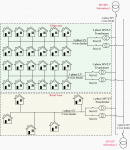mbrooke
Batteries Included
- Location
- United States
- Occupation
- Technician
And don't think I don't know what your doing. You know the mods will delete this thread and that is your goal.
All because the thought of pulling power lines under ground goes against the "norm"
I put norm in quotes because plenty of other countries found a way to get distro underground.
All because the thought of pulling power lines under ground goes against the "norm"
I put norm in quotes because plenty of other countries found a way to get distro underground.


